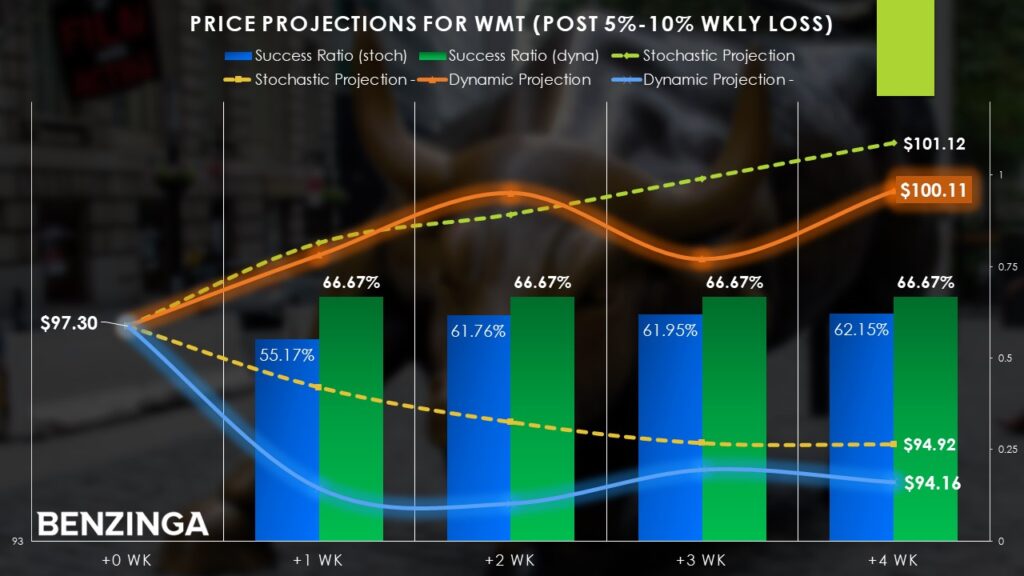Zinger Key Points
- Walmart’s Q4 results beat estimates but a cautious outlook due to tariff fears clouded sentiment.
- However, fundamental resilience and a buy-the-dips mentality potentially bode well for WMT stock.
- Pelosi’s latest AI pick skyrocketed 169% in just one month. Click here to discover the next stock our government trade tracker is spotlighting—before it takes off.
Like clockwork, Walmart Inc WMT posted strong earnings results, delivering fourth-quarter adjusted earnings per share of 66 cents on top of revenue of $180.55 billion. Both figures beat their respective analyst consensus targets of 64 cents and $180.01 billion. Unfortunately, the one avenue that disappointed Wall Street was the forward guidance, sending the stock tumbling down.
To be sure, earnings misses themselves are rare. Going back to May 2020, Walmart has only failed to meet analysts' estimates twice. In terms of revenue, the big-box retailer has a perfect record during the aforementioned period. However, concerns over the stock — particularly due to macroeconomic or geopolitical events — are nothing new. This framework may offer hope amid the current downbeat news.
Isolated to just the fourth-quarter results, the storyline appears quite optimistic. For example, Walmart's gross margin rate was up 53 basis points, thanks in large part to its core domestic business. Operating income increased by 8.3% to about $600 billion. Further, same-store sales for Walmart U.S. climbed by 4.6%, excluding fuel.
However, management disclosed that first-quarter adjusted EPS may only land between 57 cents and 58 cents, noticeably below the estimate of 64 cents. For fiscal year 2026, adjusted EPS may range between $2.50 to $2.60, below analysts' consensus view of $2.76. Naturally, new tariffs introduced by President Donald Trump on goods produced in China, India, Mexico and Canada weighed heavily on investors.
Nevertheless, it's important to remember that in May 2019, Walmart warned that prices would rise due to the trade war at the time with China. Such disclosures ultimately didn't hurt the stock. That may have been for the reasons UBS analyst Michael Lasser is providing now for why the retailer could be resilient: "price leadership, buying power, and global sourcing capabilities."
Historical Price Trends Suggest Volatility In Walmart Stock As A Discount
Perhaps the sweetest irony amid the red ink is that Walmart — the leader of the everyday low-pricing business model — is now offering a discount on its own equity. Typically, volatility represents a warning sign. However, for a relevant behemoth like Walmart, the downside has consistently shown itself to be a discounted opportunity.
Primarily, long-side speculators largely benefit from the upward bias of Walmart stock. Using data since January 2019, a purely stochastic or temporal view of Walmart reveals that a position entered at the beginning of the week has about a 55.2% chance of rising by the end of it. Over the next four weeks, the long odds actually rise to over 62%.
However, something interesting happens when Walmart stock encounters unusual volatility. For the current week, the security is on pace to lose more than 6%. Whenever Walmart incurs a one-week loss between 5% and 10%, the subsequent week sees long odds pop to nearly 67%. This stat stays consistent for the next four weeks, resulting in a median return (assuming the positive scenario) of 2.89%.

To be fair, such big losses in Walmart stock are rare: it's only happened six times since January 2019 so the dataset is extremely small. However, if Walmart manages to mitigate the weekly red ink to below 5%, the odds would still favor the long-side speculator. Over the next four weeks following modest volatility, the long odds are still around 62%.
While historical trends aren't guaranteed to repeat, the optimistic view — despite tariff fears — makes sense. Walmart doesn't just exercise scale and pricing power, which are enormous advantages to begin with. For years, it has also diversified into higher-margin goods, which was reflected in the fourth-quarter report.
A Bold Options Strategy to Consider
Given the bounce-back tendencies of Walmart’s stock, buy-and-hold investors may consider the present dip as a possible entry point. For aggressive traders, the red ink is arguably more compelling. With so much fear baked into the forward guidance and the impact of tariffs, Walmart call options appear relatively underpriced.
The most daring traders may consider a multi-leg options strategy called the bull call spread for the options chain expiring March 21; specifically, the 97.50/100 bull spread. This transaction calls for buying the $97.50 call and simultaneously selling the $100 call. By taking the proceeds from the short call, the trader partially offsets the debit paid for the long call.
At time of writing, the net debit required for this trade is $109, which is also the most that can be lost. On the other end, the maximum reward possible is $141 or a payout of over 129%. Share prices will need to rise by over 2.8% at expiration to hit the $100 short-strike target, thus triggering the payout.
To note, bull call spreads are capped-risk, capped-reward transactions. The lower-priced long call meets the potential obligation implied by the higher-priced short call. However, many traders are willing to engage such transactions because it allows them to potentially profit handsomely from relatively small moves in the underlying equity.
Now Read:
Image: Shutterstock
Edge Rankings
Price Trend
© 2025 Benzinga.com. Benzinga does not provide investment advice. All rights reserved.
Trade confidently with insights and alerts from analyst ratings, free reports and breaking news that affects the stocks you care about.